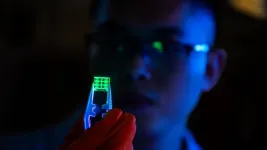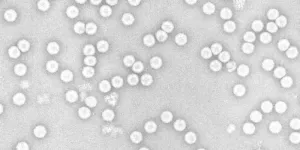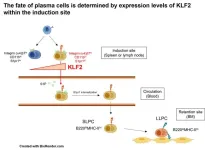(Press-News.org) Cost, technical performance and environmental impact – these are the three most important aspects for a new type of LED technology to have a broad commercial impact on society. This has been demonstrated by researchers at Linköping University in a study published in Nature Sustainability.
“Perovskite LEDs are cheaper and easier to manufacture than traditional LEDs, and they can also produce vibrant and intense colours if used in screens. I’d say that this is the next generation of LED technology,” says Feng Gao, professor of optoelectronics at Linköping University.
However, for a technological shift to take place, where today’s LEDs are replaced with those based on the material perovskite, more than just technical performance is required. That is why Feng Gao’s research group has collaborated with Professor Olof Hjelm and John Laurence Esguerra, assistant professor at LiU. They specialise in how innovations contributing to environmental sustainability can be introduced to the market.
Together, they have investigated the environmental impact and cost of 18 different perovskite LEDs, knowledge that is currently incomplete. The study was conducted using so-called life cycle assessment and techno-economic assessment.
Such analyses require a clear system definition – that is, what is included and not in terms of cost and environmental impact. Within this framework, what happens from the product being created until it can no longer be used is investigated. The life cycle of the product, from cradle to grave, can be divided into five different phases: raw material production, manufacturing, distribution, use and decommissioning.
“We’d like to avoid the grave. And things get more complicated when you take recycling into account. But here we show that it’s most important to think about the reuse of organic solvents and how raw materials are produced, especially if they are rare materials,” says Olof Hjelm.
One example where the life cycle analysis provides guidance concerns the small amount of toxic lead found in perovskite LEDs. This is currently necessary for the perovskites to be effective. But, according to Olof Hjelm, focusing only on lead is a mistake. There are also many other materials in LEDs, such as gold.
“Gold production is extremely toxic. There are byproducts such as mercury and cyanide. It’s also very energy-consuming,” he says.
The greatest environmental gain would instead be achieved by replacing gold with copper, aluminium or nickel, while maintaining the small amount of lead needed for the LED to function optimally.
The researchers have concluded that perovskite LEDs have great potential for commercialisation in the long term. Maybe they can even replace today’s LEDs, thanks to lower costs and less environmental impact. The big issue is longevity. However, the development of perovskite LEDs is accelerating and their life expectancy is increasing. The researchers believe that it needs to reach about 10,000 hours for a positive environmental impact, something they think is achievable. Today, the best perovskite LEDs last for hundreds of hours.
Muyi Zhang, PhD student at the Department of Physics, Chemistry and Biology at LiU, says that much of the research focus so far is on increasing the technical performance of LED, something he believes will change.
“We want what we develop to be used in the real world. But then, we as researchers need to broaden our perspective. If a product has high technical performance but is expensive and isn’t environmentally sustainable, it may not be highly competitive in the market. That mindset will increasingly come to guide our research.”
END
Cheap and environmentally friendly – the next generation LEDs may soon be here
Towards sustainable perovskite light-emitting diodes
2025-03-11
ELSE PRESS RELEASES FROM THIS DATE:
Rare frog rediscovered after 130 years
2025-03-11
A team of researchers has rediscovered a frog species which has not been seen in more than 130 years. First described in 1902, Alsodes vittatus had evaded detection since then, despite multiple search efforts. The researchers discovered two populations of the frog at the southeastern end of the ancient Hacienda San Ignacio de Pemehue in La Araucanía Region, Chile. The rediscovery is an important milestone for South American herpetology and the conservation of biodiversity in the southern cone.
The frog Alsodes vittatus is an elusive creature – described in 1902, it managed to go undetected for more than a century. Now, after a decade of investigation, a research team ...
Earth's 'dirty mirror' effect is accelerating climate change
2025-03-11
Earth is absorbing more sunlight and trapping more heat than it releases into space, causing our planet to warm up at an increasing rate.
New research shows that cloudy areas over oceans are reflecting less sunlight to space than before, adding to heating from rising greenhouse gas levels and causing climate change to accelerate.
The study, published today (Tuesday, 11 March) in Environmental Research Letters, found this dimming effect was occurring in several regions, including cloudy areas off the coasts of California and Namibia, ...
Breakthrough in next-generation polio vaccines
2025-03-11
A more affordable, lower-risk polio vaccine is on the horizon, research led by the University of Leeds has found.
Researchers have taken a major step towards producing a more affordable and lower-risk polio vaccine using virus-like particles (VLPs). These particles mimic the outer protein shell of poliovirus, but are empty inside. This means there is no risk of infection, but the VLP still causes the immune system to respond.
Now, a research project led by Professor David Rowlands, Emeritus Professor of Molecular Virology at the University of Leeds, has tested the effectiveness of using different yeast, insect, mammalian and ...
A call for federally funded pediatric firearm injury prevention research
2025-03-11
BOSTON, MASSACHUSETTS – Firearm-related injuries are the leading cause of death among children and adolescents in the United States, yet research on firearm injury prevention receives significantly less federal funding compared to other major pediatric health concerns. A new paper published in Pediatrics underscores the critical need for an enhanced federal investment in firearm injury prevention research to address the rising rates of fatalities and injuries.
“Expanding the field of firearm injury ...
New research reveals how a 252 million year old climate crisis accompanied the ‘Great Dying’ mass extinction event, completely reorganizing the Earth’s ecosystems
2025-03-11
The mass extinction that ended the Permian geological epoch, 252 million years ago, wiped out most animals living on Earth. Huge volcanoes erupted, releasing 100,000 billion metric tons of carbon dioxide into the atmosphere. This destabilized the climate and the carbon cycle, leading to dramatic global warming, deoxygenated oceans, and mass extinction. However, many plants survived, leaving behind fossils which scientists have used to model a dramatic 10 degree rise in global temperatures.
“While fossilized spores and pollen of plants from the Early Triassic do not provide strong evidence for a sudden and catastrophic ...
Untangling quantum entanglement with new calculation formulas
2025-03-11
Once described by Einstein as “spooky action at a distance,” quantum entanglement may now seem less intimidating in light of new research findings.
Osaka Metropolitan University physicists have developed new, simpler formulas to quantify quantum entanglement in strongly correlated electron systems and applied them to study several nanoscale materials. Their results offer fresh perspectives into quantum behaviors in materials with different physical characteristics, contributing to advances in quantum technologies.
Quantum entanglement is a unique phenomenon ...
Adults abused as children twice as likely to develop health and mental health conditions
2025-03-11
Toronto, ON – A new study published this week in Child Maltreatment found that in comparison to those who had not been abused in childhood, adults who had experienced both childhood physical and sexual abuse had approximately double the odds of physical and mental health conditions, including angina, arthritis, asthma, COPD, heart attack, depression, and disability -- even after considering respondents’ age, race, income, and health behaviors, as well as obesity.
Those who had been sexually abused, but not physically abused, were 55% ...
A dive into erythritol slurry and its potential for waste heat recovery
2025-03-11
Energy efficiency is crucial for sustainability, yet vast amounts of low-temperature waste heat remain unused in industrial processes. Now, researchers from Japan have investigated erythritol slurry as a promising heat transfer medium for thermal storage and transport. By analyzing its flow behavior and non-Newtonian properties, they developed a predictive equation for its rheological characteristics. Their findings could help guide the design of industrial waste heat recovery systems, advancing energy efficiency and carbon neutrality.
Energy efficiency is one of the most important pillars of our global sustainability goals. Simply put, one of the most straightforward and effective ...
No place like home—how proteins that plasma cells express at their origin affect migration
2025-03-11
Osaka, Japan – Vaccine effectiveness relies on creating a strong antibody response that can be reactivated to fight future infections. Now, researchers from Japan report that antibody-producing cells are destined for longevity from the moment they are born.
In a recent study published in the Journal of Experimental Medicine, a multi-institutional research team led by Osaka University reveals that a key cell population involved in long-term immunity to infection is programmed early in its lifecycle to travel to protected sites in the body.
Plasma cells originate in lymphoid ...
Socioeconomic factors fuel global inequalities in Alzheimer's disease burden, study finds
2025-03-11
Ann Arbor, March 11, 2025 – An analysis of the global burden and temporal trends of Alzheimer's disease and other dementias (ADODs) reveals significant cross-country inequalities associated with a series of sociodemographic development-related risk factors, such as education, income, fertility, and health expenditure. The new study in the American Journal of Preventive Medicine, published by Elsevier, calls for the development of targeted prevention and control strategies in different countries.
The burden of ADODs has risen globally over the past three decades. The authors of this first systematic and comprehensive global study analyzing ...
LAST 30 PRESS RELEASES:
Blocking a key inflammatory pathway improves liver structure and vascular function in cirrhosis, study finds
Continuous spread: Raccoon roundworm detected in nine European countries
HKUST Engineering researchers developed a novel photodetector to enhance the performance of on-chip light monitoring
Strategic river sensors could have forewarned of Texas Camp flood disaster
Drone sampling of whale breath reveals first evidence of potentially deadly virus in Arctic
Roman soldiers defending Hadrian’s Wall infected by parasites, study finds
Pinochet’s prisoners were tormented with music but still found solace in it, a new book reveals
Fertility remains high in rural Tanzania despite access to family planning
AI-assisted device can improve autism care access
Kinetic careers
Uncovering how parasitic plants avoid attacking themselves to improve crop resistance
Nanoparticle vaccine strategy could protect against Ebola and other deadly filoviruses
Study finds brain care score can predict risk of stroke across racial groups
Key lung immune cells can intensify allergic reactions
Do hormones explain why women experience more gut pain?
New materials conduct ions in solids as easily as in liquids
Breakthrough of the Year: Renewable energy begins to eclipse fossil fuel-based sources
LLM use is reshaping scientific enterprise by increasing output, reducing quality and more
Introducing LightGen, a chip for ultra-fast, ultra-efficient generative AI
Astronomers see fireworks from violent collisions around nearby star
ACC/AHA issue new guideline on managing congenital heart disease in adults
Cosmic crash caught on camera
Is talented youth nurtured the wrong way? New study shows: top performers develop differently than assumed
Ants: An untapped resource in the development of antibiotics?
Archaeologists use AI to create prehistoric video game
Mitochondria migrate toward the cell membrane in response to high glucose levels
Tiny viral switch offers hope against drug-resistant bacteria
Most parents aware of early peanut introduction guidelines, but confused about details
HPV vaccine can protect against severe lesions of the vulva and vagina
Virtual care provision and emergency department use among children and youth
[Press-News.org] Cheap and environmentally friendly – the next generation LEDs may soon be hereTowards sustainable perovskite light-emitting diodes







